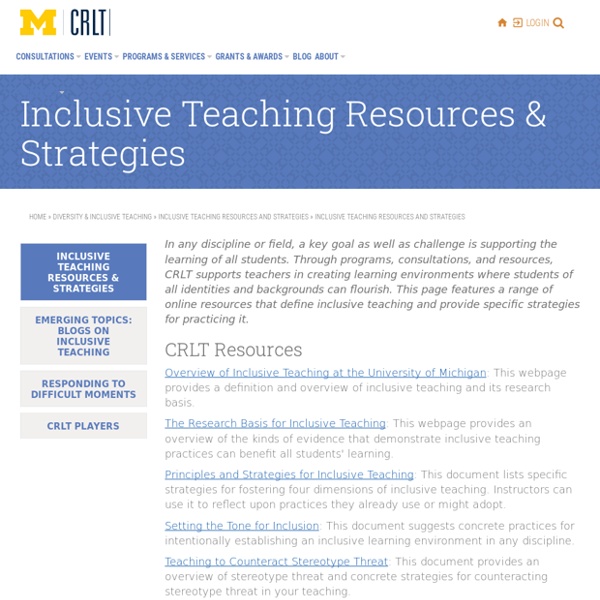Increasing Inclusivity in the Classroom
Print Version by Andrew Greer, Graduate Teaching Fellow The goals of this teaching guide are threefold: 1) to discuss the importance of inclusivity in the classroom, 2) to present examples of teaching more inclusively, and 3) to provide additional resources for further guidance. Why is inclusivity important? Drawing from the literature on inclusive teaching in higher education, the current section considers the importance of increasing inclusivity and is framed by two overarching issues.
Chapter 11
Chapter 11: Inclusive education 19In almost every country, inclusive education has emerged as one of the most the dominant issues in the education of SWSEN. In the past 40 years the field of special needs education has moved from a segregation paradigm through integration to a point where inclusion is central to contemporary discourse.
A.9 Culture and learning environments
Old Sun Anglican Aboriginal School, Southern Alberta: note the Union Jack on the board at the back A.9.1 The importance of culture Within every learning environment there is a prevailing culture that influences all the other components.
4.3 Enabling culturally appropriate and relevant learning environments : Doing Better for Māori in Tertiary Settings
“…at the heart of successful education for all Māori learners is the provision of a culturally responsive environment” (Kāhui Tautoko Consulting Ltd, 2012a, p.19). There is a strong understanding across the literature that Māori learners are more likely to engage and persist with their studies when they feel that they are a central part of the learning environment, and that they belong. This is particularly important for learners who have experienced being on the margins educationally and socially. Māori learners are more likely to feel a part of the institution if it is culturally relevant to them (Phillips and Mitchell, 2010; Kāhui Tautoko Consulting Ltd, 2012a; Tahau-Hodges, 2010). The construct of whānaungatanga is intrinsic to a sense of belonging in the tertiary education environment.
Culturally responsive learning environments / Pedagogy / The arts / Home - Senior Secondary
Teachers of the arts create culturally responsive learning environments and contexts for all students if they recognise, reflect and validate their history, cultures, and worldviews in the classroom curriculum. The culturally responsive pedagogies used in this guide were developed by the arts writing team and advisors from the University of Auckland to provide teachers with strategies to engage all students in learning. They are about valuing diversity as an asset, and validating culture, language and identity as essential to learning success. They recognise several factors informing education and influencing educational outcomes. These are:
Inclusion / Principles
This section draws together research, digital resources, and examples to support schools as they consider the inclusion principle. Inclusion is one of eight principles in The New Zealand Curriculum that provide a foundation for schools' decision making. The principle of inclusion can be used to guide formal curriculum policy and planning, classroom programmes, and teaching practice. The curriculum is non-sexist, non-racist, and non-discriminatory; it ensures that students’ identities, languages, abilities, and talents are recognised and affirmed and that their learning needs are addressed.The New Zealand Curriculum, p. 9. The principle of inclusion applies to all students in all New Zealand schools.
CTI - Incorporating Diversity
Incorporating diversity involves designing your course with varied course materials, teaching methods and learning activities that accommodate a diverse group of students with a range of learning styles, abilities, experiences, and cultures. It may also mean that issues of diversity are part of the course learning outcomes and topics related to diversity are embedded within the course content. Brown, S.
CTI - Inclusive Teaching Strategies
Inclusive teaching strategies refer to any number of teaching approaches that address the needs of students with a variety of backgrounds, learning styles, and abilities. These strategies contribute to an overall inclusive learning environment, in which students feel equally valued. Why use inclusive teaching strategies? “Even though some of us might wish to conceptualize our classrooms as culturally neutral or might choose to ignore the cultural dimensions, students cannot check their sociocultural identities at the door, nor can they instantly transcend their current level of development… Therefore, it is important that the pedagogical strategies we employ in the classroom reflect an understanding of social identity development so that we can anticipate the tensions that might occur in the classroom and be proactive about them” (Ambrose et. al., 2010, p. 169-170).
Inclusive practices
Inclusive Practice and the School Curriculum Ko te ākonga te pūtake o te ako. The learner is at the centre of learning.



